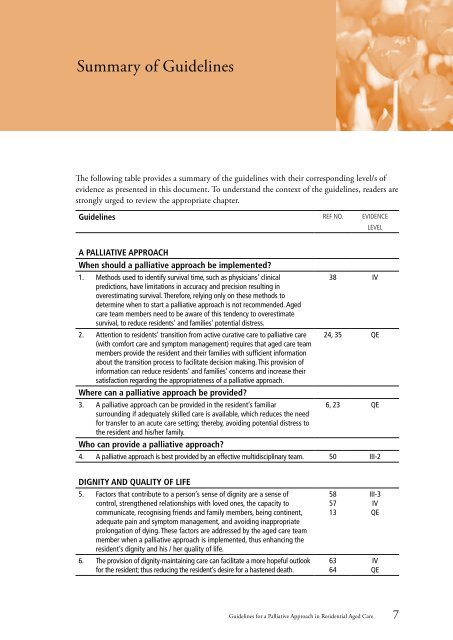Guidelines for a Palliative Approach in Residential Aged Care
Guidelines for a Palliative Approach in Residential Aged Care
Guidelines for a Palliative Approach in Residential Aged Care
You also want an ePaper? Increase the reach of your titles
YUMPU automatically turns print PDFs into web optimized ePapers that Google loves.
Summary of <strong>Guidel<strong>in</strong>es</strong><br />
The follow<strong>in</strong>g table provides a summary of the guidel<strong>in</strong>es with their correspond<strong>in</strong>g level/s of<br />
evidence as presented <strong>in</strong> this document. To understand the context of the guidel<strong>in</strong>es, readers are<br />
strongly urged to review the appropriate chapter.<br />
<strong>Guidel<strong>in</strong>es</strong> Ref No. Evidence<br />
level<br />
A PALLIATIVE APPROACH<br />
When should a palliative approach be implemented?<br />
1. Methods used to identify survival time, such as physicians’ cl<strong>in</strong>ical<br />
predictions, have limitations <strong>in</strong> accuracy and precision result<strong>in</strong>g <strong>in</strong><br />
overestimat<strong>in</strong>g survival. There<strong>for</strong>e, rely<strong>in</strong>g only on these methods to<br />
determ<strong>in</strong>e when to start a palliative approach is not recommended. <strong>Aged</strong><br />
care team members need to be aware of this tendency to overestimate<br />
survival, to reduce residents’ and families’ potential distress.<br />
2. Attention to residents’ transition from active curative care to palliative care<br />
(with com<strong>for</strong>t care and symptom management) requires that aged care team<br />
members provide the resident and their families with sufficient <strong>in</strong><strong>for</strong>mation<br />
about the transition process to facilitate decision mak<strong>in</strong>g. This provision of<br />
<strong>in</strong><strong>for</strong>mation can reduce residents’ and families’ concerns and <strong>in</strong>crease their<br />
satisfaction regard<strong>in</strong>g the appropriateness of a palliative approach.<br />
Where can a palliative approach be provided?<br />
3. A palliative approach can be provided <strong>in</strong> the resident’s familiar<br />
surround<strong>in</strong>g if adequately skilled care is available, which reduces the need<br />
<strong>for</strong> transfer to an acute care sett<strong>in</strong>g; thereby, avoid<strong>in</strong>g potential distress to<br />
the resident and his/her family.<br />
Who can provide a palliative approach?<br />
38 IV<br />
24, 35 QE<br />
6, 23 QE<br />
4. A palliative approach is best provided by an effective multidiscipl<strong>in</strong>ary team. 50 III-2<br />
DIGNITY AND QUALITY OF LIFE<br />
5. Factors that contribute to a person’s sense of dignity are a sense of<br />
control, strengthened relationships with loved ones, the capacity to<br />
communicate, recognis<strong>in</strong>g friends and family members, be<strong>in</strong>g cont<strong>in</strong>ent,<br />
adequate pa<strong>in</strong> and symptom management, and avoid<strong>in</strong>g <strong>in</strong>appropriate<br />
prolongation of dy<strong>in</strong>g. These factors are addressed by the aged care team<br />
member when a palliative approach is implemented, thus enhanc<strong>in</strong>g the<br />
resident’s dignity and his / her quality of life.<br />
6. The provision of dignity-ma<strong>in</strong>ta<strong>in</strong><strong>in</strong>g care can facilitate a more hopeful outlook<br />
<strong>for</strong> the resident; thus reduc<strong>in</strong>g the resident’s desire <strong>for</strong> a hastened death.<br />
58<br />
57<br />
13<br />
63<br />
64<br />
III-3<br />
IV<br />
QE<br />
IV<br />
QE<br />
<strong>Guidel<strong>in</strong>es</strong> <strong>for</strong> a <strong>Palliative</strong> <strong>Approach</strong> <strong>in</strong> <strong>Residential</strong> <strong>Aged</strong> <strong>Care</strong>
















